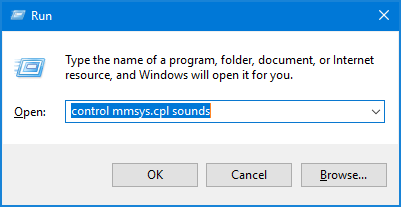
- #Reset sound settings windows 10 batch file how to
- #Reset sound settings windows 10 batch file download
Well, try out any of these and write to us if you have more tips on this. However, RDP should incorporate some options that could help out users to reset the connection data and its settings as well. This is extremely easy as it only requires you to run the file. If you are comfortable using Registry, then go ahead with the batch file. This will immediately Reset Remote Desktop Connection Data.

Step 2 – Extract the contents of the file and double-click the.
#Reset sound settings windows 10 batch file download
Step 1 – Click the below Download button to grab the batch file. If not working then you can try reset sound. You can Reset Remote Desktop Connection Data altogether without having admin rights by downloading the following file. Rd C:\Users\–USER FOLDER–\Documents\Default.rdp Method 2 – Batch File Once the black panel opens up, copy/paste the below syntax and press Enter to execute it. Step 1 – To begin with, on the Search field, type in cmd and hit Ctrl + Shift + Enter keys. Similarly, you can also delete the file by running the cmd code. In order to see that, you can check the Hidden items located under the view tab. If there arises a need to reset RDP settings, remove a specific file namely “ Default.rdp” inside the Documents folder.Īs a matter of fact, the file might be a hidden one. Here also, you need to delete the similar hostnames you deleted in Server Key. Step 5 – There is a key for each Remote Desktop Server under the Servers key. This includes all the info of your “Remote Desktop Server IP/HostName as Data”. Step 4 – If you prefer to delete a specific one, you need to expand the Default key and delete the value as shown REG_SZ on its right pane. Note – Removing the above-mentioned keys will reset all the connection data. Select both the keys ( Default and Servers) and press Delete on the keyboard. Step 3 – You can notice two keys below Terminal Server Client – Default and Servers. HKEY_CURRENT_USER\SOFTWARE\Microsoft\Terminal Server Client Step 2 – On the left sidebar of Registry, navigate to the below path. When UAC prompt comes into view, click Yes to proceed. Step 1 – Click Start and type in the command regedit. However, for convenience, you can also download and run the batch file to easily Reset Remote Desktop Connection Data. As a matter of fact, it is necessary for you to first Import and Export Registry Editor on Windows 10. But some of the users may make mistakes in doing so, and they modify the registry incorrectly. There is only a single procedure to effortlessly Reset Remote Desktop Connection Data in Windows 11 or 10 and that is a simple registry hack. Step 4: Restart your Windows computer to finish the operation.Reset Remote Desktop Connection Data in Windows 11 and 10 netsh winsock reset netsh winhttp reset proxy netsh winhttp reset tracing netsh winsock reset catalog netsh int ipv4 reset catalog netsh int ipv6 reset catalog Step 3: Then run the following commands, one by one, and confirm with Enter for each of them. Step 2: Type the following command, then validate with the Enter key on your keyboard. Or press WIN + R, type CMD, and press Enter.

Click on the Start menu, type CMD in the search box, then right-click on it and select Run as administrator. Step 1: There are two ways to open the command line.
#Reset sound settings windows 10 batch file how to
How to Reset Network Settings in Windows 10 Don’t panic! Try resetting your network settings instead, you never know, you might get Internet access back. If you have recently changed ISP (Internet Service Provider) and therefore box and your computer can no longer connect to the Internet. In this tutorial, we are going to see how to reset network settings in Windows 10.


 0 kommentar(er)
0 kommentar(er)
